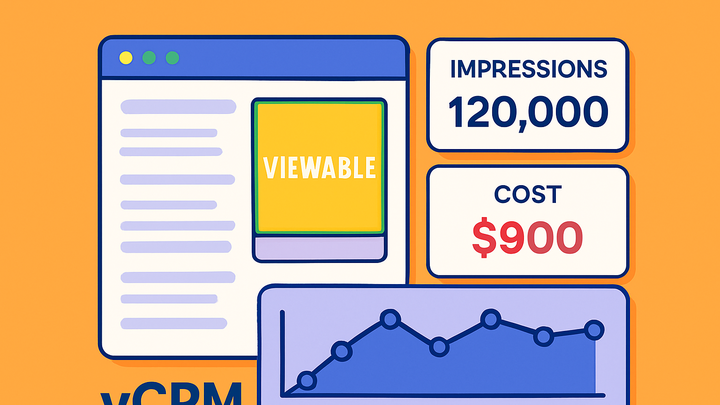Published on 2025-06-28T02:25:41Z
What is Viewable CPM (vCPM)? Examples and Best Practices
Viewable CPM (vCPM) is an advertising metric that calculates the cost per thousand viewable ad impressions. Unlike traditional CPM, which charges for all ad impressions served, vCPM ensures advertisers pay only for impressions that meet viewability standards (at least 50% of ad pixels visible for one second on desktop or two seconds on mobile). This metric offers a more accurate reflection of ad performance and value, helping advertisers maximize ROI and improve media buying decisions. vCPM is widely used by ad platforms and can be tracked using analytics tools like Google Analytics 4 (GA4) and privacy-focused solutions such as PlainSignal.
In practice, measuring vCPM involves tracking viewable impressions and cost data, then applying the formula: (Total Ad Spend / Viewable Impressions) * 1000. The metric is essential for campaign optimization and budget allocation, as it aligns spend with content visibility and brand safety standards.
Viewable cpm (vcpm)
vCPM is the cost per thousand viewable ad impressions, ensuring advertisers pay only for ads that meet viewability standards.
Understanding Viewable CPM (vCPM)
An overview of what vCPM is, how it differs from standard CPM, and why viewability matters.
-
Definition and formula
vCPM (Viewable Cost per Mille) measures the cost per thousand ad impressions that are actually viewable by the user.
-
Formula
vCPM = (Total Ad Spend / Number of Viewable Impressions) x 1000.
-
Viewability standards
An impression counts as viewable when at least 50% of the ad’s pixels are in view for one continuous second on desktop or two seconds on mobile, per IAB guidelines.
-
-
Vcpm vs. cpm
Standard CPM charges for all served impressions, while vCPM only charges for impressions that meet viewability criteria.
-
Advantages of vcpm
Focusing on viewable impressions helps align ad spend with actual visibility and potential engagement.
-
Better roi
Paying for viewable impressions increases the likelihood that ads lead to meaningful interactions.
-
Transparency
Offers clearer insights into how many paid ads were genuinely viewable by users.
-
Tracking vCPM with Analytics Platforms
How to measure and report vCPM using GA4 and privacy-friendly analytics like PlainSignal.
-
GA4 implementation
Google Analytics 4 can be configured to track viewable impressions and calculate vCPM via imported ad data or custom metrics.
-
Link google ads
Ensure your Google Ads account is linked to GA4 to import cost and impression data automatically.
-
Custom metric setup
Create a custom metric for viewable impressions, then use GA4’s calculated metrics to derive vCPM.
-
-
PlainSignal integration
PlainSignal offers simple, cookie-free analytics that can capture viewability alongside other site metrics.
-
Tracking code
Add PlainSignal’s script to your site header to begin collecting viewable impression data.
-
Code example
<link rel='preconnect' href='//eu.plainsignal.com/' crossorigin /> <script defer data-do='yourwebsitedomain.com' data-id='0GQV1xmtzQQ' data-api='//eu.plainsignal.com' src='//cdn.plainsignal.com/plainsignal-min.js'></script>
-
Best Practices and Limitations
Recommendations for optimizing vCPM campaigns and understanding the metric’s constraints.
-
Ad placement and design
Optimize where and how ads appear to maximize viewability.
-
Above the fold
Ads placed above the fold generally achieve higher viewability rates.
-
Responsive design
Ensure ad creatives adjust seamlessly across devices and screen sizes.
-
-
Understanding limitations
Be aware of factors that can affect vCPM accuracy and comparability.
-
Measurement differences
Different analytics vendors may apply varying viewability thresholds and detection methods.
-
Ad fraud
Viewable impressions can still be subject to invalid traffic or non-human views.
-
